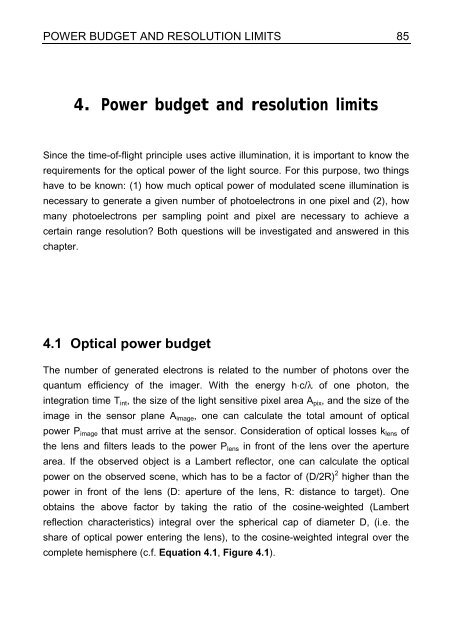3D Time-of-flight distance measurement with custom - Universität ...
3D Time-of-flight distance measurement with custom - Universität ...
3D Time-of-flight distance measurement with custom - Universität ...
You also want an ePaper? Increase the reach of your titles
YUMPU automatically turns print PDFs into web optimized ePapers that Google loves.
POWER BUDGET AND RESOLUTION LIMITS 85<br />
4. Power budget and resolution limits<br />
Since the time-<strong>of</strong>-<strong>flight</strong> principle uses active illumination, it is important to know the<br />
requirements for the optical power <strong>of</strong> the light source. For this purpose, two things<br />
have to be known: (1) how much optical power <strong>of</strong> modulated scene illumination is<br />
necessary to generate a given number <strong>of</strong> photoelectrons in one pixel and (2), how<br />
many photoelectrons per sampling point and pixel are necessary to achieve a<br />
certain range resolution? Both questions will be investigated and answered in this<br />
chapter.<br />
4.1 Optical power budget<br />
The number <strong>of</strong> generated electrons is related to the number <strong>of</strong> photons over the<br />
quantum efficiency <strong>of</strong> the imager. With the energy h⋅c/λ <strong>of</strong> one photon, the<br />
integration time Tint, the size <strong>of</strong> the light sensitive pixel area Apix, and the size <strong>of</strong> the<br />
image in the sensor plane Aimage, one can calculate the total amount <strong>of</strong> optical<br />
power Pimage that must arrive at the sensor. Consideration <strong>of</strong> optical losses klens <strong>of</strong><br />
the lens and filters leads to the power Plens in front <strong>of</strong> the lens over the aperture<br />
area. If the observed object is a Lambert reflector, one can calculate the optical<br />
power on the observed scene, which has to be a factor <strong>of</strong> (D/2R) 2 higher than the<br />
power in front <strong>of</strong> the lens (D: aperture <strong>of</strong> the lens, R: <strong>distance</strong> to target). One<br />
obtains the above factor by taking the ratio <strong>of</strong> the cosine-weighted (Lambert<br />
reflection characteristics) integral over the spherical cap <strong>of</strong> diameter D, (i.e. the<br />
share <strong>of</strong> optical power entering the lens), to the cosine-weighted integral over the<br />
complete hemisphere (c.f. Equation 4.1, Figure 4.1).

















